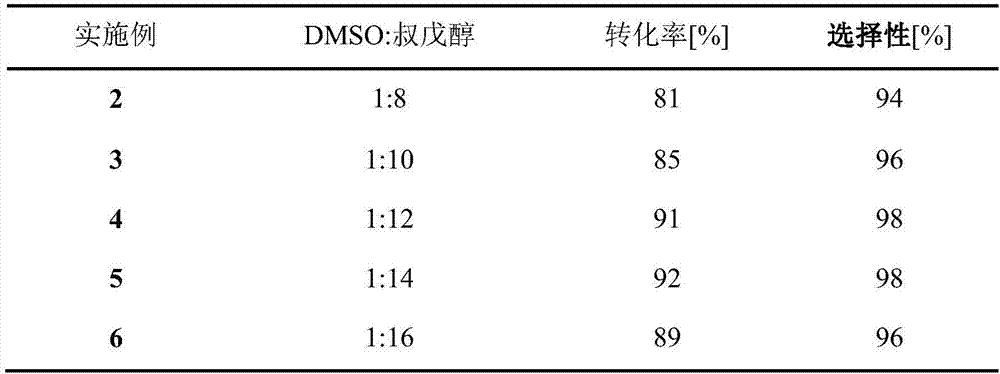Method for synthesizing 5'-O-lauroyl-5-methyluridine on line through catalyzing of lipase
A methyl uridine, lipase technology, applied in biochemical equipment and methods, biochemical instruments, enzyme production/bioreactors, etc., can solve the problems of low conversion rate and selectivity, long reaction time, etc., to shorten the time Effects of reaction time, reduced reaction cost, high conversion and selectivity
- Summary
- Abstract
- Description
- Claims
- Application Information
AI Technical Summary
Problems solved by technology
Method used
Image
Examples
Embodiment 1
[0025] Example 1: Synthesis of 5'-O-lauroyl-5-methyluridine
[0026]
[0027] device reference figure 1 : Dissolve 5-methyluridine (1.0mmol) in 1.33mL DMSO and 8.67mL of tert-amyl alcohol, and dissolve vinyl laurate (9.0mmol) in 10mL of tert-amyl alcohol, and then put them in 10mL syringes for use. 0.87g of lipase Lipozyme TLIM was evenly filled in the reaction channel, and driven by the PD 1200 syringe pump, the two reaction solutions were separated at 10.4 μL min -1 The flow rate enters the reaction channel through the "Y" joint for reaction, and the temperature of the reactor is controlled at 30°C by a water bath thermostat. The reaction solution flows continuously in the reaction channel for 30 minutes, and the reaction results are tracked and detected by thin-layer chromatography (TLC).
[0028] Collect the reaction solution online by the product collector, remove the solvent by distillation under reduced pressure, use 200-300 mesh silica gel wet packing column, the e...
Embodiment 2-6
[0033] The volume ratio of the organic solvent in the microfluidic channel reactor was changed, and the temperature was controlled at 50°C. Others were the same as in Example 1. The reaction results are shown in Table 1:
[0034] Table 1: Effect of Organic Solvent Ratio on Reaction
[0035]
[0036] The results in Table 1 show that when the flow rate is 10.4 μL min -1 , the reaction time is 30min, the reaction temperature is 50°C, the molar ratio of reactant 5-methyluridine to vinyl laurate is 1:9, and the concentration of 5-methyluridine in the reaction system is 0.05mmol / mL, the conversion rate increases with the increase of the organic solvent volume ratio in the reactor, and reaches the best when the DMSO: tert-amyl alcohol volume ratio reaches 1:14, and then continuing to increase the volume ratio will cause the reactant to dissolve incompletely and cause lower conversion rates. Therefore, the optimal organic solvent volume ratio in the microfluidic microchannel rea...
Embodiment 7-11
[0038] Change the substrate molar ratio of 5-methyluridine to vinyl laurate in the microfluidic microchannel reactor, and control the temperature to 50°C. Others are the same as in Example 1. The results are shown in Table 2:
[0039] Table 2: Effect of 5-methyluridine and vinyl laurate substrate molar ratio on reaction
[0040]
[0041]
[0042] The results in Table 2 show that when the flow rate is 10.4 μL min -1 , the reaction time is 30min, the reaction temperature is 50°C, the organic solvent DMSO in the reactor: the volume ratio of tert-amyl alcohol is 1:14, and the concentration of 5-methyluridine in the reaction system is 0.05mmol / mL, Along with the increase of reactant vinyl laurate, the conversion rate of reaction also increases, and when 5-methyluridine and vinyl laurate substrate molar ratio are 1:9, the conversion rate of reaction is optimal, so The optimum substrate molar ratio in the microfluidic microchannel reactor of the present invention is 1:9.
PUM
 Login to View More
Login to View More Abstract
Description
Claims
Application Information
 Login to View More
Login to View More - Generate Ideas
- Intellectual Property
- Life Sciences
- Materials
- Tech Scout
- Unparalleled Data Quality
- Higher Quality Content
- 60% Fewer Hallucinations
Browse by: Latest US Patents, China's latest patents, Technical Efficacy Thesaurus, Application Domain, Technology Topic, Popular Technical Reports.
© 2025 PatSnap. All rights reserved.Legal|Privacy policy|Modern Slavery Act Transparency Statement|Sitemap|About US| Contact US: help@patsnap.com



